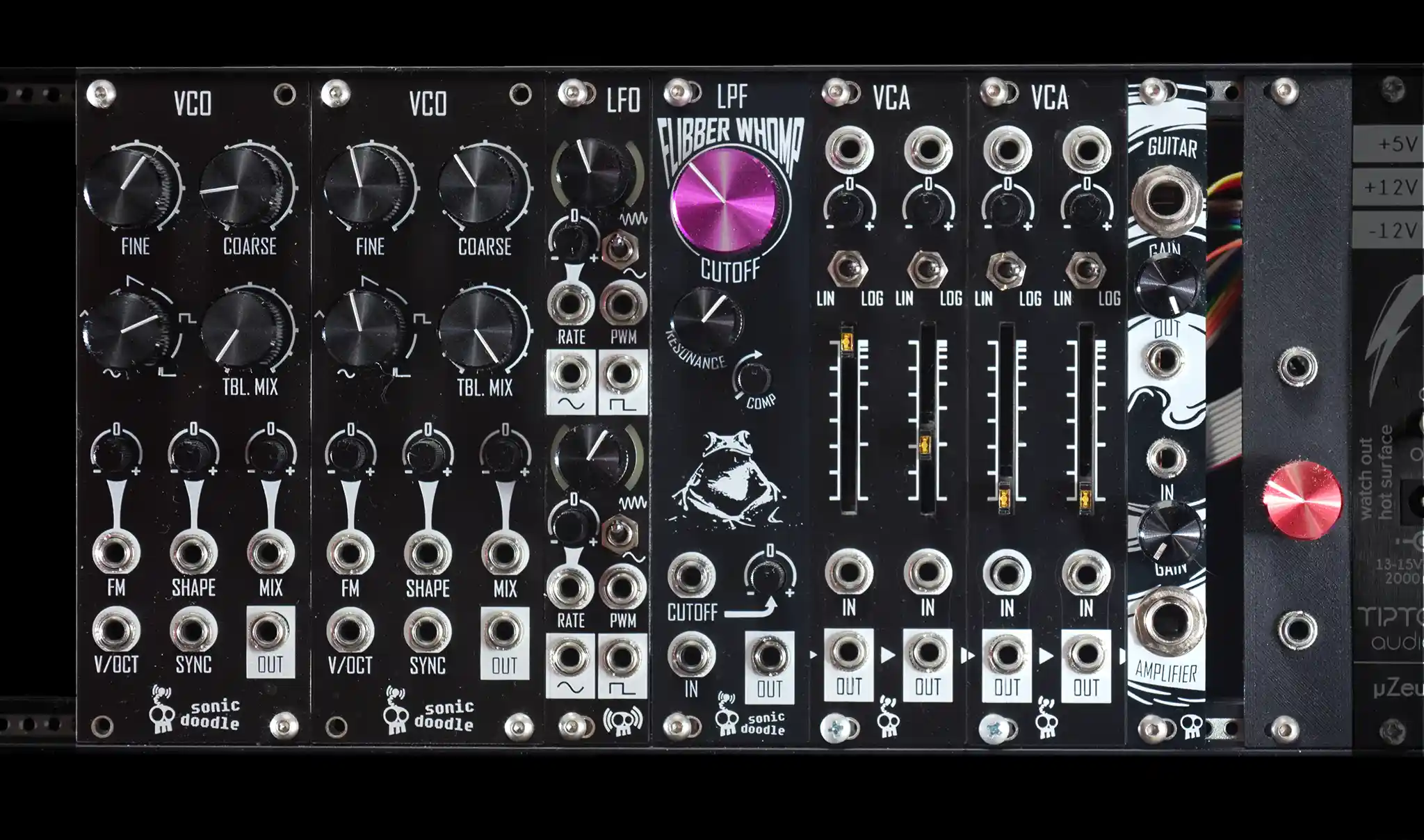John R. Mitchell IV
Projects
Modular Synthesizer

This is a project that I have been working on since around 2021. Usually in between semesters of school when I have a chunk of free time. It is based on the Eurorack system, which defines the physical dimensions of the modules, the power delivery, and general ranges for control and audio voltages.

Voltage Controlled Oscillator
My first module is the Voltage Controlled Oscillator (VCO). It is a wavetable VCO utilizing an ATMega328p microcontroller. The user can choose between Sine, Triangle, Sawtooth, Square, and Pulse waveforms, or anything in between! Intermediate waveforms are interpolated in software.
There is also a custom wavetable which can be blended with the standard waves using the “Tbl. Mix” control.
Coarse and Fine Pitch controls are available and all controls are also optionally voltage controlled. All CV inputs have “attenuverters” — At 12-oclock, the CV inputs do nothing, as the knob is turned right, the CV level increases, as the knob is turned left, the CV level is inverted.
It also features a sync input which (in conjunction with another oscillator and the custom wavetable) produces some of the most tonally bizarre sounds you can't think of.
Low Frequency Oscillator
The Low Frequency Oscillator (LFO), was designed and built along with the VCA during winter 2021-2022. It is all analog and features a sine-ish or Square output. Internally, an analog voltage controlled oscillator generates a triangle wave, which is converted into a sine with a waveshaper. The frequency control has a CV input for modulation.
There is also a square wave output. An optional CV will modulate the width, allowing for pulse signals.
Voltage Controlled Amplifier
The Voltage Controlled Amplifier (VCA) utilizes the LM13700 Operational transconductance amplifier at its heart. This module features logarithmic or linear control, slider potentiometers, and once again attenuverters for the CV inputs. These modules also act as mixers. Each VCA module is connected to it’s neighbor on the back, if no output on a channel is plugged in, the output is fed into the output of the channel to its right. This allows any number of inputs to be mixed to any number of outputs, up to the number of inputs available. Currently, only two modules are built (4 channels total), but a third is in the process of being built, which will allow up to 6 channels to be mixed.
Voltage Controlled Filter
The voltage controlled filter (VCF) also uses LM13700 OTA's like the VCA. It is a four pole low pass with resonance control. A fairly basic tool in the realm of modular synthesizers, but still incredibly useful.
This VCF also has a "compensation" control, which helps maintain volume when high resonance is used.
Why is it called Flibber Whomp? Some say it is named after the great forest guardian who blocks the way to the magic land of Modularia Synthasium. Others say it is the greatest enemy of the Krackalackin' Kraken, both locked in mortal combat for centuries. Or perhaps it just kinda sound like the word "Filter" and the sound of a 4 pole LPF with a bit of resonance.
Future Modules
The nature of modular synthesizers means they can be slowly put together over time. This is what drew me to them when I first chose to build this. The overall synthesizer will never be “finished” as more modules will be built, and modules will be replaced. If this rack is filled, more can be added.
For the past couple of years I have been developing an envelope generator module that simulates a mass-damper-sping system. I am currently working on creating input parameters that are easy to understand, have a full range of usefulness, and wont cause instability in the simulation (unless desired for those oh so fun *avant-garde ambience sessions*).
Guitar Effects Pedals
My first dive into designing electronics was DIY guitar effects pedals. It started off with a Mosrite Fuzzrite clone that I cobbled together with various components that I salvaged from broken toys, electronics, and a very handy build-you-own radio kit from my childhood. This first pedal (which very quickly fell apart) was built on cardboard, with component leads and wires merely twisted together. But it worked! And this little circuit sparked this new hobby.
After that first effect I slowly built up my collection of components and tools. My first “proper” pedals were usually built point to point or on perfboard, housed in whatever random containers I could find; the “paintcan” fuzz was popular among my musician friends. One of those friends commissioned me to build a bass fuzz in a cigar box, thus my first sale and the beginning of “Sonic Doodle Effects.”
Electric Guitar
My guitar was built by hand with reclaimed wood from an old workbench. It is called the “Krackalackin’ Kraken.”
It started out as a small project where I just wanted to build a custom guitar body out of some scrap wood, but it became much more. In the end I created a custom pickguard, electronics, jack plate, and a wipe-on oil paint finish.
It features a ’59 “PAF style” humbucker and a ’65 “strat style” single coil. The 5 way selector switch can split the humbucker pickup and mix with the single coil for a variety of interesting sounds.
I learned a lot from this project and it has become my go-to guitar.